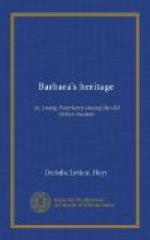“Now about Botticelli,” he added. A little rustle of expectancy swept through the group of listeners. Bettina drew nearer Barbara and clasped her hand; and all settled themselves anew with an especial air of interest. “I see you, like most other people, care more for him. He is immensely popular at present. It is quite the fashion to admire him. But, strangely enough, only a few years ago little was known or cared about his work, and his name is not even mentioned by some writers on art. He was first a goldsmith like Ghirlandajo, then afterward became a pupil of Fra Filippo Lippi, father of the Filippino Lippi who finished Masaccio’s frescoes in the Brancacci Chapel. Botticelli wrought an immense service to painting by widening greatly the field of subjects hitherto assigned to it, which had been confined to Bible incidents. Others, contemporary with him, were beginning to depart slightly from these subjects in response to the desires of the pleasure-loving Florentines of that day; but Botticelli was the first to come deliberately forth and make art minister to the pleasure and education of the secular as well as the religious world. By nature he loved myths, fables, and allegories, and freely introduced them into his pictures. He painted Venuses, Cupids, and nymphs just as willingly as Madonnas and saints.
“I hope you will read diligently about him. The story of how his pictures, and those of other artists who were influenced by him, led to the protest which Savonarola (who lived at the same time) made against the ‘corrupting influence of profane pictures’ and his demand that bonfires should be made of them is most interesting. Botticelli devotedly contributed a large number of his paintings to the burning piles.”
“But he painted religious pictures also, did he not?” queried Barbara.
“Oh, yes. His works were wrought in churches as well as in private houses and palaces. He even received the honor of being summoned to Rome by Pope Sixtus IV. to assist in the decoration of the Sistine Chapel of the Vatican, where Michael Angelo afterward performed his greatest work. There he painted three large religious frescoes—by the way, Ghirlandajo painted there also. Now we must find what is the charm in Botticelli’s painting that accounts for the wonderful present interest in his work. I think it is in a large degree his attempt to put expression into faces. While Masaccio had taken a long step in advance of other artists by making man himself, rather than events, the chief interest in his pictures,—Botticelli, more imaginative and poetic, painted man’s moods,—his subtile feelings. You are all somewhat familiar, through their reproductions, with his Madonna pictures. How do these differ from those of other painters?”
“The faces are less pretty.”
“They are sad instead of joyous.”
“In some the little Christ looks as though he were trying to comfort his mother.”




